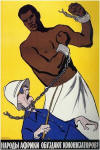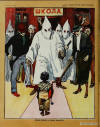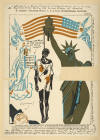
People of Africa will defeat colonization

Don't extinguish the dawn of freedom

Dark child, dark souls

In the course of investigation local Mansi tribes natives also appeared as suspects in the Dyatlov Pass Incident. In fact only Mansi were ever detained under suspicion in the deaths of the Dyatlov Pass Incident. The reason for this was not racist profiling. In fact Soviet Union at the time was very liberal toward other nationalities and races. Peoples' Friendship University of Russia, for example, was opened on February 5th, 1960. It was specifically catered for students from Third World countries. Similar student exchange programs were later opened in many other Soviet universities.
For more on the culture of Khanty and Mansi see Culture of the peoples of Russia
 People of Africa will defeat colonization |
 Don't extinguish the dawn of freedom |
School Dark child, dark souls |
 |
The reason for suspecting Mansi native was religious in nature. Some even remembered a story from the 30's when a woman geologist ventured into sacred lands of this proud unconquered nation. She was subsequently tied and thrown in the lake. However upon closer examination this legend doesn't have factual support. It was probably invented later to justify the arrest of the Mansi hunters. Common diary as well as a second diary (unknown author) that was found in the tent also talked about the Mansi and their presence in the region. Other native tribes by the way were not seen by the Dyatlov group, search party or anyone else for that matter.
Mansi were an easy target for suspicion. They were part of a hunter gatherer society that were never part of the mainstream society. They kept their way of life, traditions and most importantly their religion intact despite over 400 years under rules of Russians. Nikita Khrushchev who ruled Soviet Union at the time started the second wave of anti- religious campaign in the country. Anyone who pursued or was interested in any form of religion was ridiculed and discriminated against. Thus pagan Mansi were initially perceived as easy targets for a scape goat in this mysterious and unusual case. Several hunters even became suspects in the criminal investigation into the Dyatlov Pass Incident. Natives themselves didn't hide a fact that were camped out not far from the site of the Dyatlov Incident, thus they were quiet close. Brilliant scientists killed by religious backward religious fanatics. This narrative was too good to pass for the Soviet propaganda, yet this theory quickly hit a wall and fell apart.
Soviet anti religious posters from the time period
Mansi theory was quickly abandoned for the lack of evidence or any possible initiative to kill. Soviet propaganda simply could not sell the idea that Kholat Syakhl was somehow important to the natives in the area. Everybody knew that it was a lie. Mount Kholat Syakhl was never viewed a sacred place. It was feared and it was avoided, but no one considered it important for the beliefs of the native people. If the Soviets could sell the idea about sanctity of the region, they would have arrested Mansi, give them lengthly sentences and the case would be closed.
Witness report by Pavel Makhtiyarov (Mansi native)
"Everyone goes to this mountain: Russian men and women, Mansi. There is no special prohibition to climb the mountain"
Additionally natives in the Ural mountains and most of Siberia are practical people. Their harsh environment forces them to take the best opportunity of what they have. If the Mansi were involved in the murder of the tourists they would probably steal many valuable possession that are so important to survival in the harsh climate of Siberia. However all the items in the tent were left as is. Nothing was stolen, nothing was taken. Furthermore, Mansi natives helped in search of bodies. It would be fairly dumb to leave bodies on top of the "sacred site" if you knew dozens of Russians will descend on the mountain in search of their dead friends. You probably would want to move them somewhere else. Criminal investigation clearly points out that Kholat Syakhl was never considered sacred. All the participants of the search also reported on numerous times that the Mansi never showed any anger or concern for the presence of the Russians in this area. In fact native tribes were willing to help in a search party.
Svetlana Oss: "Don't go There" and Khanty killers

The Khanty killers theory. It was first stated in a book by a Russian investigative journalist Svetlana Oss in her book "Don't go There!". While her analysis of an autopsy report and witness testimonies point to a reasonable assumption of violent deaths of the tourists of the Dyatlov group, her attempt to blame the murder on Khanty natives, explain their motifs and methods of accomplishment has significant gaping holes that she fails to address.
So lets start with the Khanty people. This is another native Siberian tribe that lives to the east of the Ural mountains. However, they never lived in the area of the Dyatlov Pass Incident and they certainly never had any sacred sites on the Mansi lands. All sacred lands are located within hunting grounds. These are usually very beautiful lands with plenty of game and sources of food. Good spirits that protect the tribe provide this source of food as a present to the people who worship them. Forbidden mountains on the other hand (like Kholat Syakhl or Otorten) are barren. These lands are inhabited by bad spirits and hence they don't offer any source of food. Furthermore bad weather makes human presence on the mountain very dangerous.
To the left is a map of a region. Blue color shades the area that
historically inhabited by the Mansi people, while the red is the
area inhabited by the Khanty natives. Red dot is a location of the
Dyatlov Pass. While both cultures share similar traditions,
lifestyles and even have languages that resemble each other these
are two distinct groups of people.
But why would Svetlana
Oss make such a redicolous claim if the lands of these tribes don't
overlap? The answer is simple. She sites police investigator Oleg
Vasnin who interviewed a 72- year old Russian hunter Anatoly
Stepochkin who in turn sites some unknown Khanty hunter who made a
claim in 1981 that he was behind an attack on the Russian tourists.
This is his alleged testimony taken from a book "Don't there!".

We don't know the name of the Khanty hunter who made this claim, we can't prove his whereabouts in 1959, we don't know what state he was in when he made this claim and we don't know why he made this claim. We can only guess, yet this testimony is the key proof of the Khanty theory. Needless to say this testimony would be dismissed in any court. First of all we have no evidence that Khanty people have the technology to create such tear gas agent. Secondly the area of Kholat Syakhl is extremely windy. Despite weeks of snowfall very little snow remains on its slopes. Strong winds blew the snow into the valleys. It is partially a reason why footprints of compressed snow were visible and it is also the reason why use of any gas is futile. It won't stay at a desired concentration.
And finally if the Khanty hunters had weapons (as Svetlana Oss claims) they could have shot the tourists and took back the loot. The book doesn't explain why the natives didn't use axes or knives the tourists carried with them. They were found in the tent and left as is. Native Khanty hunters could easily finish off the Dyatlov group using weapons that the Dyatlov group braught with them. Instead they spent an entire night killing students, thus risking being discovered or seen by the Mansi who owned this land. Again nobody saw any Khanty hunters in the region, but it will be addressed below.
A major problem with this theory is a fact that no one in the group was ever charged or suspected of stealing anything ever. Stealing fur and gold from the natives is more than just taking stuff that doesn't belong to you. Natives depend on this land and if their deer herds would die out or if they simply couldn't find any game in the forest they wouldn't have anything to trade for food. Stealing gold and fur from the natives can ultimately mean killing these people.
Svetlana Oss certainly worked with the documents of the official
criminal investigation, but she doesn't give full translation of the
documents including autopsy report, witness testimonies and etc.
Instead she cherry picks few statement to support her theory, while
completely omitting others.
Svetlana Oss mentions an eye
witness Igor Gorbushin who quotes Mansi hunter Kourikov. In his
testimony Gorbushin claimed that Kourikov have seen several Ostyaks
(or Khanty as we know them) several years ago. These people were not
very friendly with Russians and Mansi alike and didn't really
communicate with anyone. The book leaves readers regret that we
don't have a testimony by Kourikov. Certainly he would elaborate on
the Khanty hunter he have met in the region. Right?
For some
reason Svetlana Oss completely overlooks the fact that Kourikov
gives his testimony and it is included in the investigation. But his
testimony doesn't fit the picture of the Khanty killers so it was
not included in the book. Major oops. So let's see what the Kourikov
said about alleged Khanty hunters.
"No one is guarding our sacred mountain. Russian people are allowed to go there. I never claimed that five hunters of the Mansi tribe or non- Mansi tribe that the Mansi feared ever lived around the sacred mountain. Mansi never saw any outsiders in the area in question. If a member of another tribe would venture into the region some Mansi hunter would encounter them and we would know. No Mansi hunter ever mistreated a Russian before. Why and how did the tourists die I have no clue"
It is possible that Kourikov did tell Gorbushin that several years
ago Khanty passed through a region, however in the months preceding to
the Dyatlov Pass Incident no outsiders were seen in the Mansi land.
The book goes further and mentiones testimony of the Mansi hunter Petr
Bachtiyarov who was sick in the winter months, but remembers how some
unknown tourists passed through their village. The testimony is brief
and lacks details, but it is probably included to show Dyatlov group as
being friendly with the Mansi. For some reason Mrs. Oss doesn't mention
other testimonies of other members of the Bachtiyarov clan who had were
not sick and had better recollection of the tourists that passed through
the region. Pavel Bachtiyarov claims that there wer 12- 13 tourists and
they passed their village on January 1st, long before the Dyatlov group
even started their journey. Again, another oops that the book "Don't go
there!" overlooked. Diary of the Dyatlov Group never mentioned meeting
Mansi people, but only seeing the signs of their presence.
Mansi
behavior is interesting in its own right. Not only they claimed that the
land was not sacred to their tribe, they actively participated in a
search on the Dyatlov Pass and its surroundings. If we hypothetically
assume that this land did not not belong to Mansi, but to Khanty, their
behavior is incredibly risky. They could have easily walked in the same
trip as the Dyatlov group. Yet they showed no concern in exploring so-
called "sacred lands". Subsequently no acts of violence was reported
against Mansi hunter or any other tourists group that walked through
these lands. It seems that Dyatlov Pass was sacred for a very brief
period of time.
Here we need to make a footnote about some
confusion of the territorial divisions among the native Siberian people.
Every tribe has their area for hunting. These boundaries are usually
geographical features like ranges, rivers and etc. Most natives stay
within these boundaries. However people are allowed to travel through
other lands without limitations. As long as they don't hunt and don't
fish you can visit any place. If you do hunt on other tribes lands you
need to give something in return to get a safe pass. Otherwise local
tribe can attack you.
To a certain extent this rule still persists in many parts of
Siberia. Russians never conquered most of Siberia, they merely
claimed it and decided not to break the bad news to the local
population. However local tribes never minded Europeans in the area.
They traded and exchanged valuable items like guns, medications,
tools for fur and food. They had no reason to attack people who
merely traveled across their lands without taking anything from the
land. In fact no murder was ever committed on or near the Dyatlov
Pass before the Dyatlov Pass Incident and no murder have occurred
since then. If the mountain was so sacred it is very strange that
native tribes selected Dyatlov group for a merciless killing. It is
also strange that while the natives had incredible knowledge in
forensic medicine (as Svetlana Oss claims) and they didn't have a
brain capacity to remove the tent, the bodies or anything that would
draw search party and subsequent investigation to the site. Instead
they left all these evidence on their "sacred land" as a big
welcoming sign: "come here, please desecrate our mountain even
further". So by killing 9 people they apparently wanted a whole lot
of Russians and non- Russians to descent on their "sacred mountain"
in search of bodies. Brilliant plan.
And finally in this scenario radioactivity was blamed on uranium ore
that the tourists accidentally picked up along the way.
Unfortunately no hard evidence for this theory was ever presented in
the book. It is simply a guess. No one ever found presence of any
ore in the bags or the tent of the Dyatlov group despite careful
examination and analysis by the investigative group, search part and
Yury Yudin who helped identify all the items found on the site of
the Dyatlov Pass. Given his background and interest in geology it is
highly unlikely that he could overlook a presence of any minerals or
other geologic speciments found on the site.
Khanty people in a case of a Dyatlov Pass Incident is something that
comes from a left field. No one ever blamed them for the murder of
the tourists and no one ever accused them of anything. None of the
members of the search party team ever made claims that Khanty were
involved in the case. Thus this theory should be deemed as a
journalist fake, invented with an attempt to sell books and gain
fame. While the death of the tourists might be indicative of violent
and premeditated death, the nature of murders is highly unorthodox
for these people.
With this
said we are open minded and will accept any evidence that supports
this theory if you can provide us with the proof.
P.S. Mount Otorten is a mountain that the Dyatlov Group tried to
climb. Many journalists claimed that its translation means: "Don't
go there". However it an artistic invention. Nothing more. In Mansi
language this names sounds as Vot-tar-tan and it is actually a name
for another mountain few kilometers to the North of Mount Otorten,
however first Russian geographers made a mistake and called this
mountain Otorten. The actually name of Mount Otorten is called Lunt-
Chusap or a Goose nest. Mansi legend claim that after the Great
Flood a single goose survived on top of the mountain. We couldn't
find the first use of the translation "Don't go there". However it
is a pure fiction and has nothing to do with the Mount Otorten or
any other mountains in the area. But the name "Don't go there"
certainly sells more books than a Goos nest.